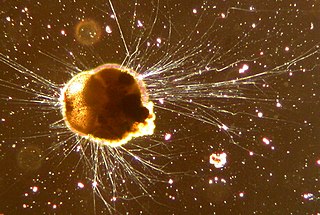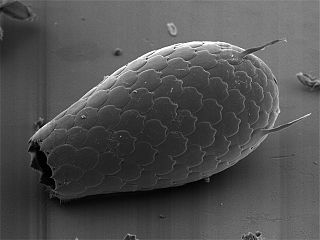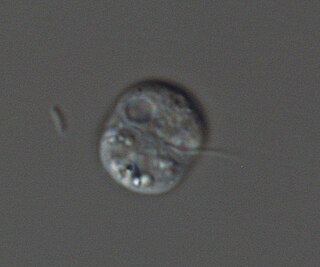
The family Vampyrellidae is a subgroup of the order Vampyrellida within the supergroup Rhizaria. Based on molecular sequence data, the family currently comprises the genus Vampyrella, and maybe several other vampyrellid amoebae. The cells are naked and characterised by radiating, filose pseudopodia and an orange colouration of the main cell body.

Cercozoa is a phylum of diverse single-celled eukaryotes. They lack shared morphological characteristics at the microscopic level, and are instead united by molecular phylogenies of rRNA and actin or polyubiquitin. They were the first major eukaryotic group to be recognized mainly through molecular phylogenies. They are the natural predators of many species of bacteria. They are closely related to the phylum Retaria, comprising amoeboids that usually have complex shells, and together form a supergroup called Rhizaria.

The Rhizaria are a diverse and species-rich supergroup of mostly unicellular eukaryotes. Except for the Chlorarachniophytes and three species in the genus Paulinella in the phylum Cercozoa, they are all non-photosynthetic, but many foraminifera and radiolaria have a symbiotic relationship with unicellular algae. A multicellular form, Guttulinopsis vulgaris, a cellular slime mold, has been described. This group was used by Cavalier-Smith in 2002, although the term "Rhizaria" had been long used for clades within the currently recognized taxon.

The euglyphids are a prominent group of filose amoebae that produce shells or tests that in most described species is reinforced by siliceous scales, plates, and sometimes spines, but this reinforcement is absent in other species. These elements are created within the cell and then assembled on its surface in a more or less regular arrangement, giving the test a textured appearance. There is a single opening for the long slender pseudopods, which capture food and pull the cell across the substrate.

Monadofilosa is a grouping of Cercozoa. These organisms are single-celled amoeboid protists.

Thecofilosea is a class of unicellular testate amoebae belonging to the phylum Cercozoa. They are amoeboflagellates, organisms with flagella and pseudopodia, distinguished from other cercozoa by their scale-lacking test composed of organic material. They are closely related to the Imbricatea, a group of testate amoebae with tests composed of inorganic silica scales.

The sarcomonads or class Sarcomonadea are a group of amoeboid biciliate protists in the phylum Cercozoa. They are characterized by a propensity to move through gliding on their posterior cilium or through filopodia, a lack of scales or external theca, a soft cell surface without obvious cortical filamentous or membranous skeleton, two cilia without scales or hairs, tubular mitochondrial cristae, near-spherical extrusomes, and a microbody attached to the nucleus.

The vampyrellids, colloquially known as vampire amoebae, are a group of free-living predatory amoebae classified as part of the lineage Endomyxa. They are distinguished from other groups of amoebae by their irregular cell shape with propensity to fuse and split like plasmodial organisms, and their life cycle with a digestive cyst stage that digests the gathered food. They appear worldwide in marine, brackish, freshwater and soil habitats. They are important predators of an enormous variety of microscopic organisms, from algae to fungi and animals. They are also known as aconchulinid amoebae.
Rigifila is a genus of free-living single-celled eukaryotes, or protists, containing the sole species Rigifila ramosa. It is classified within the monotypic family Rigifilidae. Along with Micronucleariidae, it is a member of Rigifilida, an order of basal eukaryotes within the CRuMs clade. It differs from Micronuclearia by having two proteic layers surrounding their cytoplasm instead of a single one, and having more irregular mitochondrial cristae, among other morphological differences.

Vampyrella is a genus of amoebae belonging to the vampyrellid endomyxans usually ranging from 30-60 μm. Members of the genus alternate between two life stages: a free-living trophozoite stage and a cyst stage in which mitosis occurs. This taxon has received a great deal of attention due to their peculiar feeding behaviour of perforating the cell wall of algal cells and drawing out the contents for nourishment.
Neocercomonas is a protist genus of the order Cercomonadida. It consists of single-celled bacteriophagous organisms that usually live on or nearby terrestrial plants, both above and belowground. Species are biflagellate and may grow up to 60 micrometers long, with a trailing tail-like mass of protoplasm at their posterior end and a pair of roots connecting their posterior flagellum to the cytoskeleton.

Vampyrella lateritia is a freshwater species of predatory amoebae that feeds on species of algae and is known for its specialized feeding strategy of removing, digesting, and ingesting the cellular contents of its prey. It is the type species of the genus Vampyrella and has been identified in numerous locations around the world including Brazil, Germany, and the eastern United States. Along with Vampyrella pendula, its genome was sequenced in 2012.
Nanofila is a genus of marine heterotrophic protists of the phylum Cercozoa. It is the only genus in the family Nanofilidae. It is a monotypic genus, with the sole species N. marina.
Mesofila is a genus of freshwater heterotrophic protists of the phylum Cercozoa. It is the only genus in the family Mesofilidae. It is a monotypic genus, with the sole species M. limnetica.
Minimassisteria is a marine bacterivorous genus of protists with only one species, M. diva, that presents three different lifestyle forms. It has a widespread geographic distribution. It is an amoeboflagellate most closely related to Massisteria, and together comprise the family Massisteriidae.

Orciraptor is a genus of heterotrophic protists, containing the single species Orciraptor agilis. It belongs to the family Viridiraptoridae, in the phylum Cercozoa.
Aurigamonas is a genus of predatory protists of an unusual cell structure, with two flagella and numerous haptopodia. It is a monotypic genus containing the single species Aurigamonas solis. It is the only genus of the family Aurigamonadidae.

Rhogostoma minus is a species of thecate amoeba that belongs to the phylum Cercozoa. It was first described by Belar in 1921. These amoebae are heterotrophic, which means that they consume other organisms for nutrition. The cells of Rhogostoma minus are typically between 8 and 12 μm in diameter and are surrounded by a protective organic covering called a theca. The theca has a unique cleft-like opening that allows the amoebae to extend and retract thread-like projections called filose pseudopodia. The amoebae move along surfaces by pulling themselves forward using their pseudopodia.
Rhogostomidae is a family of thecate amoebae with a ventral cleft-like aperture. Their theca is thin and flexible and adheres to the cell. The cleft-like aperture allows them to extend and retract their filose pseudopodia, which they use to move and feed. They are primarily feeding on bacteria, but they are also known to consume yeasts and algae. The family contains three genera: Capsellina, Sacciforma, and Rhogostoma.
Limnofila is a genus of heterotrophic protists that live in freshwater habitats and feed on bacteria. They are also present in the soil ecosystem, where they play an important role as predators of bacteria. They are classified as a single family Limnofilidae and order Limnofilida.







